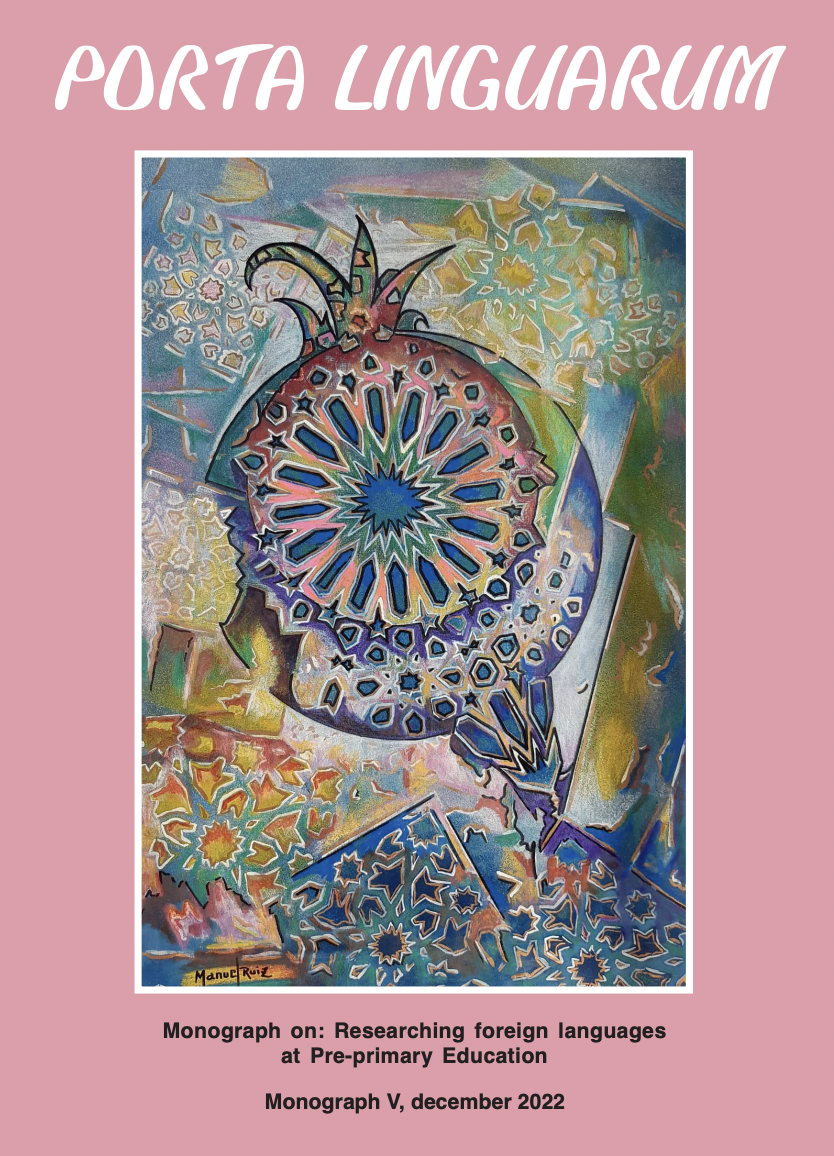Analysing preschoolers’ awareness of linguistic and cultural diversity through the DivCon model
DOI:
https://doi.org/10.30827/portalin.vi.26211Keywords:
linguistic diversity, cultural diversity, language awareness, young language learners, language awakeningAbstract
The article focuses on developing the awareness of linguistic and cultural diversity at the pre-school level. We first present the DivCon model (Diversity in Context) which promotes systematic exposure to linguistic and cultural diversity and is based on a framework which integrates six basic aspects: the journey metaphor, exposure to linguistic diversity, exposure to cultural diversity, progression from concrete to symbolic level, effective second language teaching approaches and children participation. In the second part of the paper we present the results of a qualitative study conducted in three kindergarten groups (n=40) to evaluate the model in the Slovenian context. The main aim of the study was to analyse pre-school children’s responses to the different dimensions in the model and the ways they perceive different languages and cultures. The results indicate that the participants responded positively to the activities carried out in order to evaluate the proposed model and showed that they are aware of linguistic and cultural diversity in a variety of ways. We argue that the model offers effective strategies for developing linguistic awareness and positive attitudes towards linguistic and cultural diversity at an early age.
Downloads
References
2. Asher, J. & Silvers, S. M. (2003). How to TPR abstractions: the critical role of imagination. The Journal of the Imagination in Language Learning and Teaching. New Jersey City University, ERIC, 56-61.
3. Bratož, S. & Sila, A. (2021). Developing plurilingual competence at an early age. In: C. J. MCDermott & A. Kožuh (Eds.) Educational challenges (pp.101-119). Los Angeles: Department of Education, Antioch University, 101-119.
4. Candelier, M., Camilleri, A., Castellotti, V., De Pietro, J. F., Lőrincz, I., Meißner, F.-J., Noguerol, A., & Schröder-Sura, A. (2010). A framework of reference for pluralistic approaches to languages and cultures. Competences and resources. Austria: Council of Europe.
5. Coelho, D., Andrade, A. I., & Portugal, G. (2018). The ‘Awakening to Languages’ approach at preschool: developing children’s communicative competence. Language awareness, 27(3), 197-221.
6. Cots, J. M. (2008). Knowledge about language in the mother tongue and foreign language curricula, Encyclopedia of language and education, 6, 15-30.
7. Coyle, D., P. Hood, & D. Marsh. (2010). Content and Language Integrated Learning. Cambridge University Press.
8. Čotar Konrad, S. The role of preschool teacher in empowering functionality of family of preschool child. Didactictica Slovenica, 33(1), 70–81 (2018).
9. Darquennes, J. (2017). Language Awareness and Minority Languages. In J. Cenoz, D. Gorter & S. May (Eds.), Language Awareness and Multilingualism, Encyclopaedia of Language and Education, 297-308.
10. Finkbeiner, C. & White, J. (2017) Language awareness and multilingualism: A historical overview. In J. Cenoz, D. Gorter & S. May (Eds.), Language awareness and multilingualism, encyclopedia of language and education. New York, NY: Springer International Publishing AG.
11. García, O. & Wei, L. (2014). Language, bilingualism and education. In Translanguaging: Language, bilingualism and education, 46-62. Palgrave Pivot, London.
12. Hoff, E. & Naigles, L. (2002) How children use input to acquire a lexicon. Child Development, 73(2), 418–433.
13. Laevers, F. (2005). Well-being and involvement in care settings. A process-oriented self-evaluation instrument. https://www.kindengezin.be/img/sics-ziko-manual.pdf
14. Lakoff, G. (1993). The contemporary theory of metaphor. In A. Ortony (ed.), Metaphor and thought, 202–251.
15. Lakoff, G. & Johnson, M. (1980). Metaphors we live by. Chicago: University of Chicago Press.
16. Lesar, I., Majcen, I., & Podlesek, A. (2020). Stališča (bodočih) pedagoških delavcev kot temelj kakovostnega vključevanja otrok priseljencev. Dve domovini, (52).
17. Little, D., Leung, C., & Van Avermaet, P. (Eds.). (2013). Managing diversity in education: Languages, policies, pedagogies, Multilingual matters (33).
18. Marsh, D. (2012). Content and language integrated learning (CLIL): A development trajectory. Córdoba, Spain: University of Córdoba.
19. Pirih, A. (2019). Extensive reading and changes to reading motivation in EFL among Slovene primary school pupils. Journal of Elementary Education, 12(4), 291-314.
20. Rutar, S. (2014). Multilingual learning and teaching as a principle of inclusive practice. Journal of Contemporary Educational Studies/Sodobna Pedagogika, 65(1).
21. Sayers, D. & Láncos, P. L. (2017). (Re) defining linguistic diversity: What is being protected in European language policy? SKY Journal of Linguistics, 30, 35-73.
22. de Sousa, E. B. C. (2019). Five Tips for Engaging Multilingual Children in Conversation. YC Young Children, 74(2), 24-31.
23. de Sousa, E. B. C. (2017). Promoting the contributions of multilingual preschoolers. Linguistics and Education, 39, 1-13.
24. Svalberg, A. Language Awareness research: where we are now. Language Awareness, 25(1), 1-13 (2015).
25. Štemberger, T. (2019). Raziskovanje o otrocih/z otroki: vprašanje participativnega raziskovanja z otroki. Pedagoška obzorja: časopis za didaktiko in metodiko, 34 (1), 3-18.
26. Wei, L. (2018). Translanguaging as a practical theory of language. Applied linguistics, 39(1), 9-30.



















